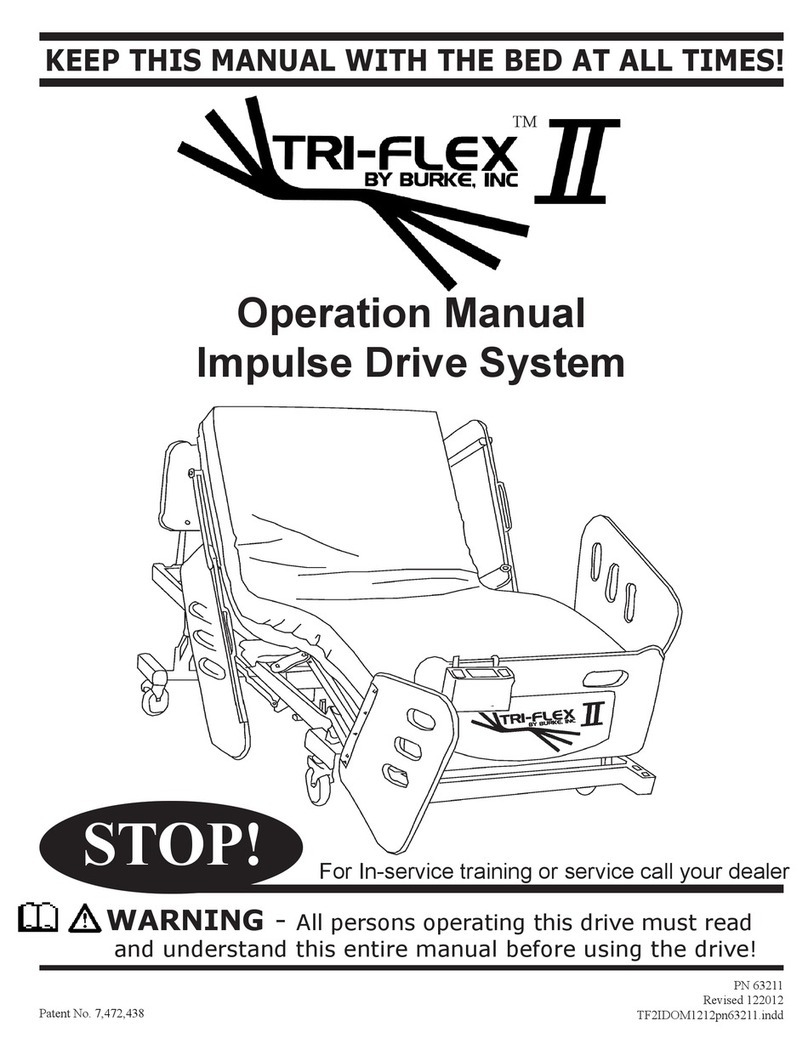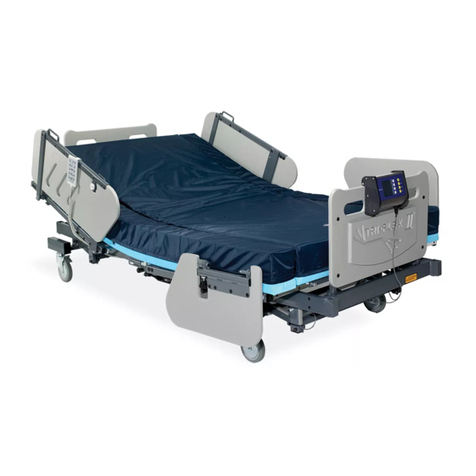
8 TRI-FLEX II BED - OPERATION MANUAL
Important Safety Information
MATTRESS INFORMATION
•Since1999theHospitalBedStandardIEC60601-2-38(1996;1999)requirestheheight
of the top edge of the side rail be at least 220mm or 22 cm (9”) above the mattress with
out compression.
•Themattressintendedforusewiththisbedis18cm(7”)thick.Useofamattress
taller than 18cm (7”) will not be in compliance with the UL-60601-1 / IEC 60601-2-38
(1996;1999)ratingofthebed.Atallermattressreducesthedistancebetweenthetopof
the side rail and the top of the mattress. Serious injury or equipment damage may occur
if the patient goes over the top of the raised side rails.
•TomaximizethefullscopeofUL60601-1/IEC60601-2-38(1996;1999),thisbedis
intendedforpatientuseinONLYthe122cm(48”)or137cm(54”)widthcongurations.
Within the current standard, patient and caregivers are safely removed from pinch points
andmovingcomponentswhichcouldcauseharm.Congurationsotherthandescribed
reduce the distance to these points which could result in severe personal injury or
equipment damage.
•Thiscontrolsystemalsoincludesabatterybackupsystemtocontinueoperationof
the bed in the event of a main power failure or during transport.
•Itisnotintendedforextendeduse,andshouldbeusedonlywhennecessaryto
accommodate patient comfort.
•Thebackupbatterywillprovidetheopportunityforseveraladjustmentsforpatient
comfort or transport during power outage.
•Inthesituationofanextendedpoweroutageitisrecommendedthatthepatientbe
removed from the bed.
POWER AND BATTERY OPERATION
•TheelectronicssystemoftheTri-FlexIIbedoperatesfromalowvoltage
power supply located under the head of the bed. To insure optimum battery
charge, please keep unit connected to a main power source.
(see optional Barri-Float / Low-Air-Loss manual for instructions on use, cleaning and disinfection)
!
ThisproducthasbeentestedtoconrmcompliancewiththeappropriateEMCstandardsac-
cording to CISPR 11, Class B.
Mostelectronicequipmentisinuencedbyradiofrequencyinterference(RFI).Cautionshould
be exercised with regard to the use of portable communications equipment in the area around such
equipment. While Burke has made every effort to ensure that RFI does not cause problems, very
strong signals could cause a movement of a section of the bed. Such movement would be of very
short duration and travel.
Itistheresponsibilityofthehealthcareprovidertoconrmthatcellphonesandotherportable
communications devices will not cause erratic behavior of other equipment. In the event that RFI does
cause erratic behavior, turn off the communications device as soon as possible. For maximum safety do
not operate the affected equipment until the source of the interference is removed. Report any malfunc-
tionstoqualiedservicepersonnel.
Electromagnetic Compatibility (EMC)






























